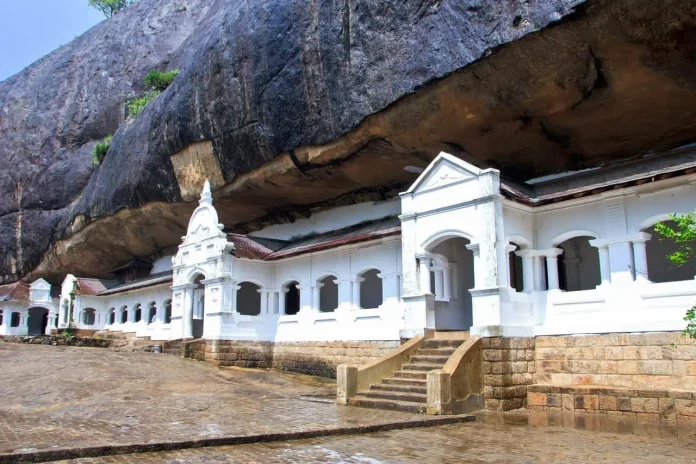The Dambulla Cave Temple is a UNESCO Universe Heritage Site located in the center of Sri Lanka on the way to Sigiriya Rock from Colombo or Kandy. We are going to discover the rich history, stunning architecture, and spiritual importance that make Dambulla a must-see location.
History Of Dambulla Cave Temple
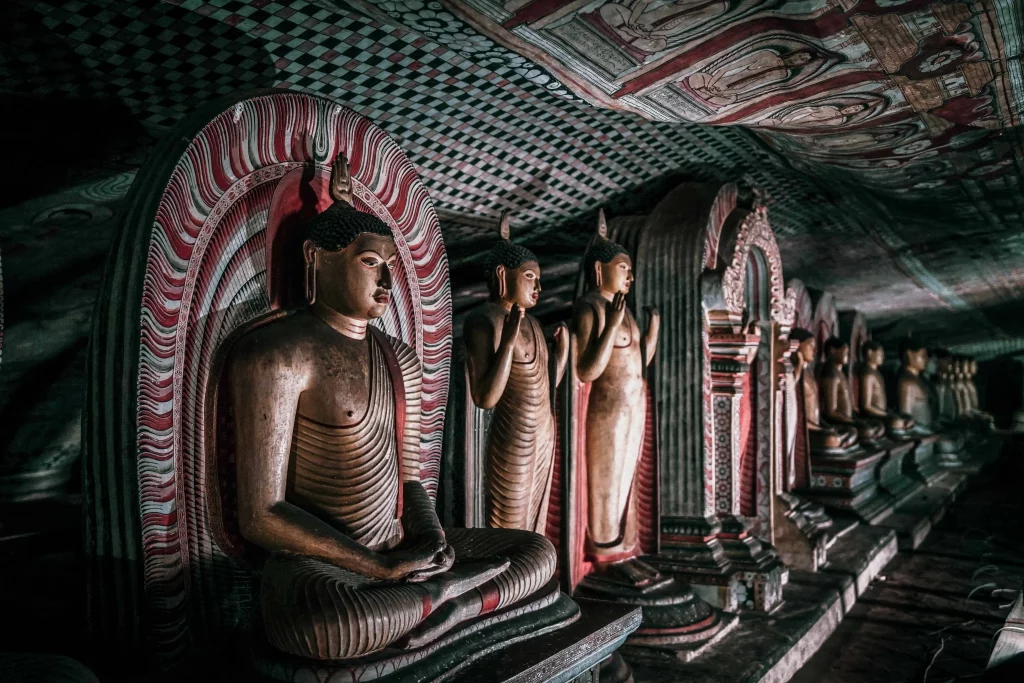
Let’s explore the wonderful Dambulla Cave Temple’s historical past. The history of this unique location spans several centuries and is both rich and interesting. It says that these caves were found by King Valagamba and he was hidden there during an attack in the first century BC. He eventually turned the caverns into a worship site of devotion, inspired by Buddhism. The temple has been important to Sri Lankan culture and Buddhism throughout the years and it has functioned as a nexus for Buddhist monks looking for spiritual enlightenment and a place for religious rites.
The intricate cave paintings and statues found within the temple walls are not only awe-inspiring but also hold immense cultural and religious significance. They depict various scenes from the life of Buddha and other important figures in Buddhism and the Dambulla Temple is witness to the rise and fall of kingdoms, the spread of Buddhism, and the preservation of Sri Lanka’s rich cultural heritage. It still exists as evidence of the tenacity of religion and the value of safeguarding Sri Lankan’s cultural assets. In addition to learning about history, visiting this holy site offers a chance to engage with a rich spiritual tradition.
Architectural Marvels
The Cave Temple in Dambulla is a true architectural marvel. The exterior of the temple boasts an impressive rock formation, known as Dambulla Rock, which towers over the landscape. The natural beauty of the area serves as a perfect backdrop for this ancient religious site.
The temple is comprised of five main caves. each meticulously carved inside of the cave’s rock face. These caves are interconnected, creating a labyrinthine network of chambers and passageways. Beautiful sculptures of Lord Buddha in a variety of stances are scattered throughout the temple, each radiating calm and spirituality as you explore it. The ambiance inside the caves is tranquil and meditative, creating a soothing environment for worship and reflection.
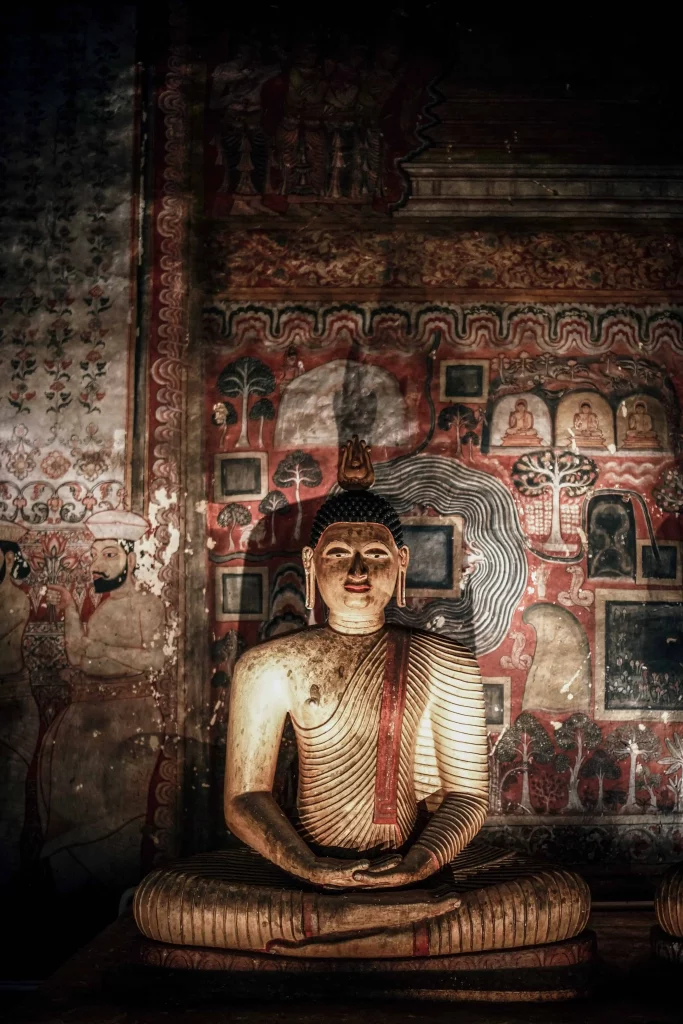
The Dambulla Cave Temple is renowned for its remarkable architectural features, notably the vibrant frescoes and intricate statues that adorn the cave walls. The paintings display the talent and skill of traditional Sri Lankan artists and represent episodes from the life of Lord Buddha. These vivid and intricate paintings offer a look into the area’s rich cultural heritage.
The temple also holds over 150 sculptures of Lord Buddha, including a stunning statue of him lying down that is an amazing 14 meters long.
Exploration of the 5 caves
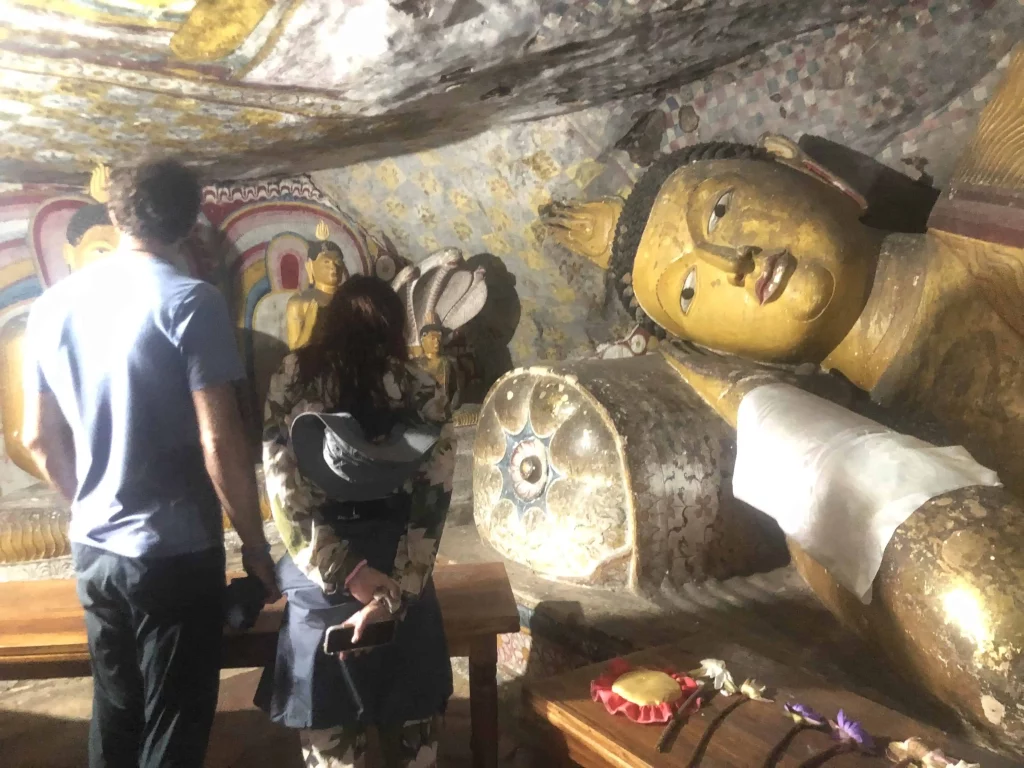
The first cave called the Cave of the Divine King or Devaraja Lena, is imposing in its magnificence and contains a massive golden statue of the Buddha.
Moving on, the magnificent cave paintings that portray various scenarios from the life of Buddha may be seen in the second cave called Maharaja Lena, also known as the Cave of the Great Kings. These paintings are a visual feast due to their brilliant colors and fine workmanship.
As you continue your exploration, the 15-meter-long reclining Buddha statue presents an amazing sight in the third cave, known as Maha Aluth Viharaya or the Great New Monastery. This amazing sculpture captivates onlookers with its unadulterated beauty and radiates a sense of serenity and tranquillity.
Buddhist traditions and Sri Lanka’s rich cultural history are revealed through religious objects such as frescoes, inscriptions, and sculptures found throughout the rest of the cave complex. These rare finds take you to a different age and allow you to see into the past.
Spiritual Significance
The Dambulla Cave Temple holds immense religious significance for Buddhists. Devotees engage in religious practices and ceremonies, creating an atmosphere of spiritual reverence. The fascination of the temple is found not only in its spectacular architectural splendor but also in the profound spiritual rituals experienced by its guests.
As a sign of respect and regard, devotees burn oil lamps and present aromatic flowers. The peaceful sounds of chanting and meditation fill the air, creating a very spiritual atmosphere and many people seek consolation and inner serenity by participating in prayer sessions and solitary contemplation
UNESCO World Heritage Site
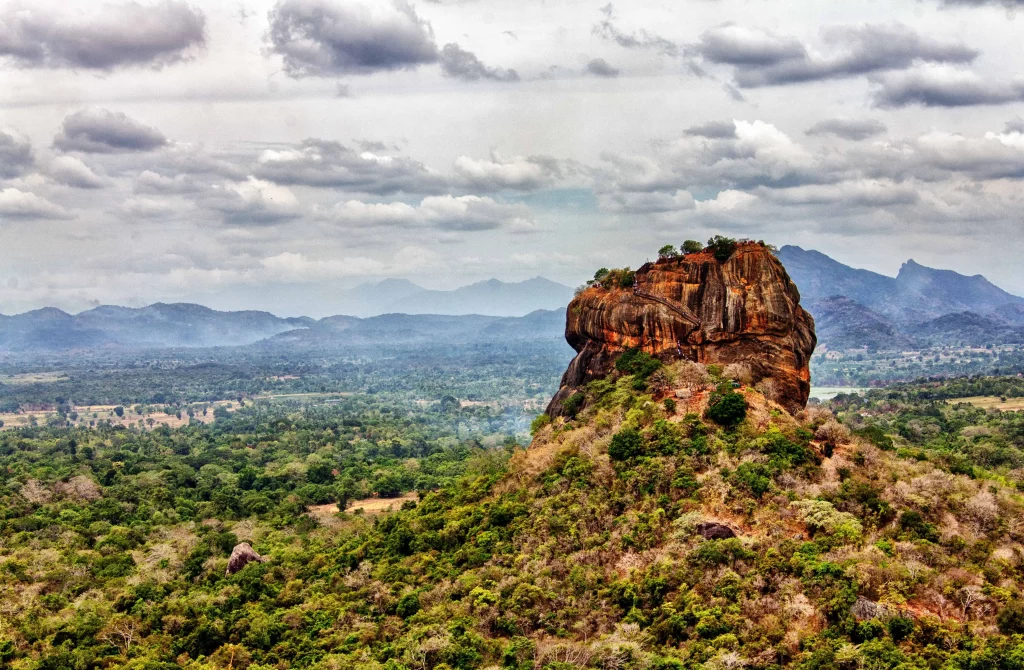
In 1991, the Dambulla Cave Temple earned its rightful place as a UNESCO World Heritage Site. Meeting stringent criteria, the temple’s inclusion on this prestigious list highlights its global importance and the need for its preservation. The recognition is not just a badge of honor for Sri Lanka but also a testament to the temple’s universal appeal.
Visitor Experience and Tourism
This magnificent temple provides an unforgettable tourist experience that will leave you speechless. The temple is available to tourists from early morning giving them plenty of opportunity to explore its grandeur.
Tips for Visitors
For those planning a visit, understanding the temple’s customs and proper etiquette enhances the experience. Dress modestly, remove shoes before entering the caves, and engage with local guides to glean insights into its history and significance.
Best Time to Visit
The best time to visit the Dambulla Cave Temple is typically during the early morning or late afternoon. These times offer a couple of advantages: fewer crowds and a more serene ambiance. In the early morning, you can catch the temple before it gets crowded, allowing for a peaceful exploration and a chance to absorb the spiritual atmosphere undisturbed. Late afternoon visits also tend to be quieter, offering a similar tranquil experience. Additionally, the lighting during these times can be especially beautiful, enhancing the aesthetics of the temple’s surroundings.
Conclusion
Dambulla Cave Temple stands as a testament to the rich tapestry of Sri Lanka’s cultural and spiritual heritage. As we conclude our exploration, the echoes of ancient whispers and the vibrant energy of the present linger in the air. We invite you to embark on your journey to witness the marvels encapsulated within this sacred sanctuary.
FAQ
- Are there any restrictions for visitors to the temple?
Visitors are required to dress modestly and remove shoes before entering the caves as a sign of respect.
- What are the temple’s opening hours?
The temple is typically open from early morning to evening. Specific hours may vary, so it’s advisable to check before planning your visit.
- Can visitors take photographs inside the caves?
Yes, photography is allowed, but it’s essential to be respectful and avoid using flash photography, which can damage delicate artwork.
- Is there an entrance fee for the temple?
Yes, there is an entrance fee for visitors, with separate fees for foreign tourists and locals.
- How old is the Dambulla Cave Temple?
The temple dates back over 2,000 years, with its initial construction in the 1st century BC.

